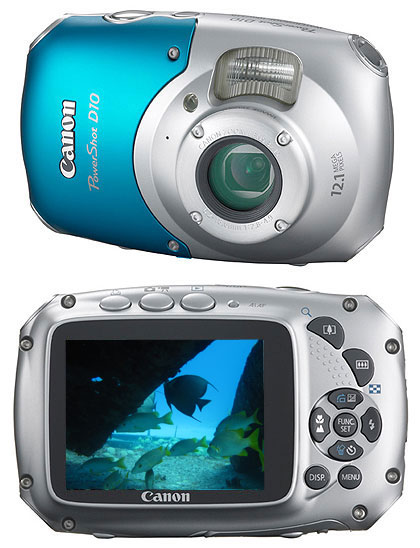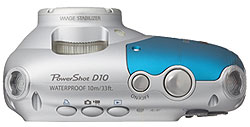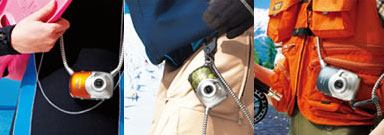|
Canon PowerShot D10
Canon's first waterproof, freeze proof and shockproof camera
(by Conrad H. Blickenstorfer and Carol Cotton)
While Canon is the leading digital camera manufacturer worldwide, the company, to the best of my knowledge, never offered a waterproof camera, or one that was specifically designed to take the kind of abuse many cameras can reasonably expect in the hands of a boating, camping, hiking and just generally outdoorsy clientele. Competitors had them, most notably Olympus and Pentax, and this year Panasonic got into the game as well. Enter Canon's new PowerShot D10, a waterproof, freezeproof and shockproof 12 megapixel camera introduced in February of 2009.
Why a waterproof/freezeproof/shockproof camera?
Canon has been selling protective underwater cases for their cameras for years, so why did they find it necessary to offer a tougher than average camera that's waterproof even without a housing?

First, because it was an unexplored market niche for them, and second because it simply makes sense. As the price of digital cameras keeps coming down, more and more people view them as expendable items that they take anywhere. Which means cameras are increasingly becoming exposed to rain, cold, drops and other abuse. So designing one that can handle those conditions is becoming important.
As far as waterproof goes, anyone into boating, kayaking, surfing, fishing, snorkeling or just hanging out by the water knows that taking pictures in the water and underwater is a wonderful experience. And being able to take photographs by the pool or at a beach without having to worry about the camera getting wet is priceless. Protective cases are a good thing, but they are big and bulky and certainly not what you want for a few quick snapshots in the surf. Further, even if you do use a protective case, it's great to know that a potential leak (and they do and will happen) would not kill the camera.
As far as freezeproof and shockproof go, that also comes in handy. Being able to take your camera skiing, snowboarding or hiking in the cold is a good thing. And drops do happen. Digital cameras are small and slippery, and it's all too easy to drop one. At the dawn of the digital camera era, a foot-and-a-half drop killed my expensive swivelbody Nikon Coolpix, and I've dropped many cameras since. I don't consider myself exceptionally clumsy, but between reviewing hundreds of cameras and cameras generally being handled at eye level and carried in pockets, the occasional drop is almost inevitable.
What does Canon offer with the PowerShot D10
This being Canon's first entry into the waterproof/rugged camera space, there are some hits and misses. From a tech spec point of view, the D10 is a 12 megapixel camera with an internal 3X optical zoom, augmented by 4X digital magnification. There is optical image stabilization and you can take VGA movies at a full 30 frames per second.  The camera has all the features and goodies common to modern digital compacts, such as advanced face recognition, predefined shooting modes that the camera can select automatically, in-camera editing tricks, and so on. The 2.5-inch LCD is of the wide viewing angle variety, and the camera is equipped with Canon's advanced proprietary DIGIC 4 image processor (DIGIC stands for Digital Imaging Core) that offers excellent speed, good noise reduction in low-light condition, advanced face recognition and more.
The camera has all the features and goodies common to modern digital compacts, such as advanced face recognition, predefined shooting modes that the camera can select automatically, in-camera editing tricks, and so on. The 2.5-inch LCD is of the wide viewing angle variety, and the camera is equipped with Canon's advanced proprietary DIGIC 4 image processor (DIGIC stands for Digital Imaging Core) that offers excellent speed, good noise reduction in low-light condition, advanced face recognition and more.
As far as ruggedness specifications go, the PowerShot D10 is waterproof to 33 feet, has an operating termperature range of 14 to 104 degrees Fahrenheit and is shockproof to four feet. To use technical ruggedness terms, the camera is sealed to NEMA IP68 specifications, and it was also tested according to procedures described in the MIL-STD-810F document, a US military standard for testing. To give you an example of what that means, the drop test specifies the camera had to be dropped onto each corner or other exposed surface three times, which for the D10 meant a total of 30 test drops.
All of this is packaged into a uniquely styled 4.1 x 2.65 x 1.9 inch body that's quite different from most other Canon cameras. The housing is matte silver with a blue insert in the front. Canon offers special straps, different color face plates (the Canon Japan website shows orange, gray and camouflage green) and even Karabiner hooks for that rugged, purposeful look.
Features
With cameras coming down in price so much, everyone is hustling to differentiate themselves with new and improved features. In the last couple of years, there's been a lot of emphasis on ever more sophisticated face recognition. Canon obviously spent a lot of time perfecting face recognition in the DIGIC 4 processor.
As a result, the D10 has several face recognition modes. In Face Priority AF mode the camera automatically optimizes all faces (up to 35). In Face Priority AE it concentrates on making sure faces are lit properly under difficult lighting conditions. In Face Priority FE, you can take flash pictures without overexposing a person's face. In Face Priority WB, the camera will make sure faces look natural even if the scene is lit with different light sources. There is also a self-timer face priority where the camera makes sure it finds the face of a person who joins the scene after the initial focus is done. DIGIC 4 also improves the camera's ability to find faces that are not head-on.
The D10's 2.5-inch LCD is relatively small in this day and age of 2.7, 3.0 and even 3.5-inch screens, but Canon made sure it offers a wide viewing angle in any direction and also applied special anti-reflective and scratch-resistant coating. There is also an "LCD booster" where you can increase the brightness with the touch of a button. Very handy.
While many consumer cameras have tiny little buttons, the PowerShot D10 has fairly large ones that are spaced far enough apart so the camera can even be operated with gloves. That comes in handy in the cold and when underwater.
The D10 offers a total of 21 shooting modes. They are auto, program and movie, and then the following 18 special scenes:
- Portrait
- Landscape
- Night Scene
- Foliage
- Snow
- Beach
- Sunset
- Fireworks
- Aquarium
- Underwater
- ISO 3200
- Long Shutter
- Indoor
- Kids & Pets
- Night Snapshot
- Color Accent
- Color Swap
- Stitch Assist
You can select from those scenes, or the camera can pick them automatically.
The D10 has an optical lens-shift anti-blur mechanism to reduce the likelihood of blurred pictures. A "safety zoom" feature combines optical and digital zoom without the sudden image degradation that can happen when you reach the end of optical magnification and go into digital. In macro mode you can go as close as 1.2 inches.
Design and controls
The overall design of the PowerShot D10 is unique, sort of a combination of playful (overall look and colors) and tough (some design elements and exposed industrial-looking screws). The body is all round and curvy, which adds to the size of the camera. The zoom is, by necessity, fully internal, but it is not of the folding variety as in other underwater cameras. This necessitates a porthole-like bulge that makes the camera almost two inches thick. Each of the four corners has a large attachment port that appears to be for an optional multi-purpose strap/karabiner.

The D10's controls are remarkably simple and mostly follow the current standard for digital cameras. As stated above, all buttons are large and spaced wide enough so you can use the camera with gloves. On top are the shutter, the on/off button, one that toggles between video and still shots, one for playback, and one for one-touch printing.
The back features has the 2.5-inch LCD sitting centered in a much larger cutout, two separate zoom buttons, and DISP and MENU buttons. There is also a five-way navigation arrangement, with the "FUNC/SET" button in the middle, and four directional buttons each of which also brings up one of the common screen menus.
On the bottom, in addition to the self-locking USB/AV, storage card and power compartment cover, are a centrally located tripod mount and a speaker.
Power
The PowerShot D10 uses a small 850 mAh, 3.7V Li-Ion NB-6L battery. A full charge is good for about 220 pictures or six hours of playback, though that depends on how often you use the LCD. Replacement batteries are inexpensive and widely available, so I'd get a spare.
How well did Canon hit the mark?
This being Canon's first entry into the rugged/waterproof camera market that's been dominated mostly by Olympus and Pentax, how well did Canon hit the mark?
On the plus side...
...it's good to have Canon in this market and it's good to be able to select Canon quality and innovation when it comes to buying a waterproof ruggedized camera. The camera's playful nautical looks make it stand out and probably fit right in with some people's outdoor gear. I also like the large and clearly marked buttons that should make handling the camera underwater and in rough conditions easier. Having 12 megapixel to play with while snorkeling, diving or snowboarding is a plus as well.
Best, probably, is that Canon's first rugged/waterproof offering is actually useful for divers as you can take it down to 33 feet. Most waterproof cameras can only handle five or ten feet, which is good enough for snorkeling but precludes scuba. Some Olympus Stylus cameras can go to 33 feet (and we've successfully tested them as deep as 75 feet), and the new D10 matches that. 33 feet is definitely scuba territory and you can dive reefs and many wrecks within that range. With the PowerShot D10, scuba divers now have a Canon camera they can take on those dives without the need for a bulky underwater housing.
We also like the way Canon made the D10 shockproof and even indicated the specific drop test procedures the camera underwent. Multiple drops from a height of four feet is impressive and it's good to know the D10 can survive an occasional drop. We also like the wide operating temperature range, which is likely even wider than Canon specifies as I'm pretty sure it can take pictures past its 104 degree fahrenheit maximum (hey, it gets up to 115 here where I live in central California).
While we haven't seen it in action, the 2.5-inch hi-res display with its anti-reflection and scratch-resistant coatings and wide viewing angle seems a good choice for an outdoor camera, and the one-touch LCD brightness boost will be much appreciated.
Canon also gave the D10 an underwater shooting mode as well as a special underwater white balance. This is important as taking pictures underwater is VERY different from shooting on dry land. Water progressively filters out certain colors (first red, then orange, etc.) which is why underwater pictures tend to look all greenish with little other color. There's also a lot of stuff floating around, making it very difficult for the camera to focus. Good underwater modes and special white balance settings can make for much better pictures underwater. How well it all works we'll see when we get a review unit.
On the minus side...
...Canon made some interesting choices, and some of them will generate criticism. The camera, for example, is quite big compared to its direct competition. It's still compact, but with a thickness of almost two inches it won't fit into many pockets whereas the smaller ruggedized Olympus models fit anywhere. As far as design goes, people will probably either love or hate its playful and somewhat cartoonish looks that are in stark contrast with the businesslike design of most Canon cameras and with almost all the competition among waterproof/rugged cameras.
While the 2.5-inch display seems bright and useful, it's fairly small for a brand-new camera. At this point we'd expect a 2.8 or 3.0 inch display. Also questionable is Canon's choice of a plain-vanilla 35-105mm equivalent zoom. While underwater it's not critical to zoom in, it is imperative to be able to get close and still have a reasonably wide angle. Starting at 35mm won't do in many situations and I hope Canon will eventually offer a waterproof camera with something along the lines of the 28-112mm zoom of the new SD880 IS.
On the movie side of things, Canon generally equips its compacts with fairly rudimentary capabilities, and the D10 is no different. So while the DIGIC 4 processor can handle H.264 encoding, all you can do is shoot basic 640 x 480 video. That's okay, but it'd be so much nicer to record what's under the surface in at least 720p high definition video.
On the features side, the D10 has all the latest in face recognition, but that will leave divers and most outdoorspeople cold. What they'd much rather have is superior speed and perhaps some extra programming in the DIGIC processor to handle all the many special conditions that confront underwater photographers. I mean, face reco is good but divers wear masks and the big issues are color compensation, backscatter avoidance, and autofocus that isn't distracted by flotsam and sediment. And, while not essential, a depth gauge/manometer would come in handy.
The Canon PowerShot D10 lists for US$329. That's okay for a camera that can handle 33 feet of depth, but still a bit costly given the relative lack of features. At US$399, the new Olympus Tough-8000, which also offers 33-foot depth and 12 megapixel, is smaller, lighter, tougher, and has a more useful wide zoom and a larger screen. The new US$399 12-megapixel/33-foot Panasonic TS1 pretty much matches the Olympus, but can also record 720p video. Canon offers 33-foot depth capability for less, but lags in other areas. Time will tell what the market decides.
Bottom line
The PowerShot D10 is Canon's first entry into the waterproof/rugged camera space where it joins offerings from Olympus, Pentax, Panasonic and a number of specialty manufacturers. The playfully styled camera is fairly large and heavy, but is also well equipped to handle most of the abuse it may encounter outdoors. It can be used in freezing weather (down to 14 degrees Fahrenheit), it is dust and waterproof, and it can handle being dropped from up to four feet. Divers can take it down to 33 feet of depth, enough for many scuba adventures. The D10 has a relatively small but bright 2.5-inch LCD display with anti-reflection and scratch-resistant treatment. The camera's controls are large and arranged so you can operate it with a glove. The basic 3X optical zoom is not optimal for underwater use where wide angle shooting is almost mandatory. Optical lens stabilization reduces blur. Thanks to Canon's DIGIC 4 processor, the camera offers speedy operation, onboard image correction, and advanced face recognition modes. The list price of US$329 is relatively high, though in line with the rugged/waterproof competition.
We like:
- Waterproof to 33 feet, dustproof, can shoot in freezing weather
- High-res anti-reflective 2.5-inch wide viewing-angle LCD with one-touch brightness boost
- Sensor shift shake reduction
- Large and well marked controls
- All the power of the DIGIC 4 processor
Not so much:
- Basic 3X optical zoom that starts at 35mm
- Only one underwater mode and one underwater white balance
- Fairly large thick and heavy
- Hit-or-miss styling
|